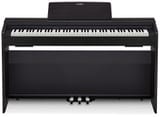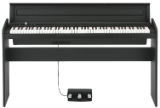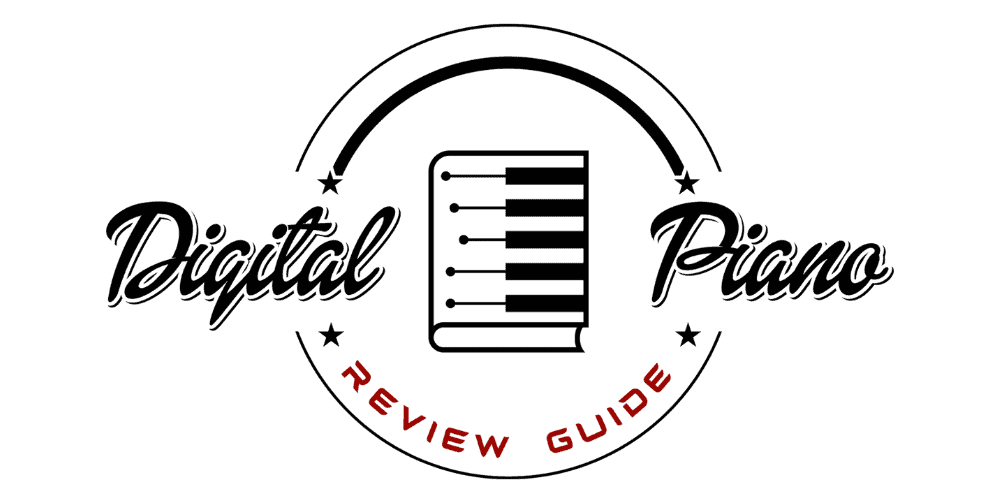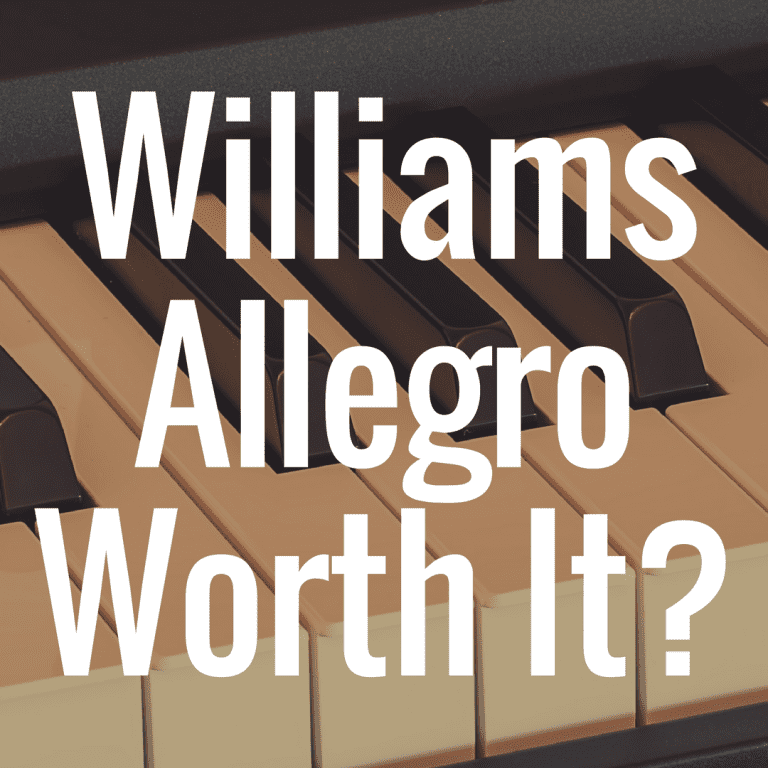Williams Allegro III Review: Quality Beginner Piano?

Shopping for a digital piano can be daunting! There are so many brands, types, features, etc. out there on the market nowadays. But you really want to learn to play piano (or someone you love really wants to learn to play piano), so you’ve decided to sally forth and shop.
Today I will discuss one of the best digital pianos for beginners: the Williams Allegro III. The Williams brand of pianos is actually a brand marketed by Guitar Center, so I scurried off to one of my local stores to take a look at this piano and play it, as well as a few others.
To better help you, please view our table below that allows you to directly compare the Allegro III to other portable pianos on the market:
| Photo | Model |
|---|---|
| Casio PX-S1100 | |
| Alesis Prestige Artist | |
| Casio CDP-S360 | |
| Yamaha P-515 | |
 | Casio PX-870 |
 | Korg LP-180 |
 | Casio PX-770 |
For the Williams Allegro III digital piano, I’ll be discussing these points in this review:
- Touch-sensitive keys versus weighted keys
- Dual-driver sound system
- Sound library
- Williams Piano App for iOS devices
- McCarthy Music app
Touch-Sensitive Keys Vs. Weighted Keys
The Williams Allegro III digital piano is an instrument that, according to its website page, is actually more suited for an advancing student or professional. This suggestion notwithstanding, it seems to also be a digital instrument highly suited for a beginner in my opinion.
A very important aspect of learning to play the piano is the touch of the instrument. The Allegro III offers 88 weighted keys—a feature that is invaluable for a beginner. Even if they aren’t the most state-of-the-art weighted keys like those on some of the higher-end digital instruments, weighted keys offer the most realistic piano “feel,” a vital aspect of learning to play any piano.
All acoustic pianos use hammers to strike strings and produce sound. If a beginner learns to play on anything less than weighted keys, they may have difficulty adjusting to the touch of an acoustic piano should they ever have need or opportunity to play such an instrument.
The keys on the Allegro III piano are longer than typical on a lower-end digital piano. This length allows the weighting to be much more similar to the weighted keys of an acoustic piano or a higher-end digital piano. Longer weighted keys provide a quicker response time and greater control for the musician.

And below, please take a look at some of the best selling digital pianos currently on sale online (and see how they compare to the pianos we discuss in this article):
| BEST SELLERS |
|---|
| 1) Yamaha P-515 |
| 2) Casio PX-S3100 |
| 3) Casio PX-870 |
| 4) Roland FP-E50 |
| 5) Roland FP-30X |
Dual-Driver Sound System
The Allegro III features a dual-driver sound system that offers great piano sounds, as well as impressive sounds for the other instruments included in its preset voices—a total of ten preset sounds. Its dual-driver system offers great clarity and depth to the instrument sounds offered by the Allegro III.
Some lesser digital pianos sometimes sound mushy or muffled as you play. Not the Allegro III! This digital piano provides realistic-sounding piano voices—some of the best I’ve heard on any instrument in this price range.
Sound Library
Let’s take a look at the Allegro III on display at my local store:

In this photograph, you can see the control panels featured on the Allegro III. Here are two close-up photographs of the control panel:

This photograph shows you the control panel on the left side of the piano. You’ll notice a Power button, a Volume button, two equalizer slides—one for low sounds and one for high sounds, the Metronome feature, and some of the other features offered on this piano.

This photograph (above) shows you the control buttons on the right side of the Allegro III. Each button controls the sounds and sound effects offered by this piano.
Williams went to great lengths to accurately record the piano sounds of a magnificent 9-foot Fazioli concert grand piano for their Allegro III. Through the use of twelve microphones, they were able to capture an authentic piano voice for their digital piano.
The organ sounds were recorded directly from vintage instruments in the hope of preserving these unique sounds for future generations. All of the voice options available on the Allegro III reflect the highest quality instrument voices available to the Williams sound engineers.
Williams Piano App for iOS Devices
Through its Bluetooth MIDI capability, the Allegro III allows the user to wirelessly connect to any iOS device. This connection gives the user access to the Williams Piano App for iOS devices, allowing the musician to control the functions of the piano.
This app also allows the user to access layering and editing options for the sounds on the piano. You can practice with a metronome or a number of other options on this piano. You can split the keyboard so that the upper section is pitched the same as the lower section. You can even re-tune the keyboard through its Tuning Fork icon, to allow you to play along with other instruments that may not be pitched at the standard 440 Hz.
With its Play Along function, the Williams Piano App lets you slow down the songs on your iTunes library without changing the pitch, so you can play along with your favorite songs! You can also loop the song, so you don’t have to restart it after each play-through.
There are many resources available on the Williams Allegro III web page to help you learn more about different styles of music and how to play them. I accessed the “Downloads” button on the site and accessed the Song Tutor materials available for the Allegro III.
Browsing through these books is well worth your time if you are an intermediate to advanced pianist. Most of the materials in the Song Tutor section of the site can be challenging even to an advanced pianist, but there are a few pieces appropriate to a late beginner or early intermediate student.
McCarthy Music App
Maybe you aren’t an intermediate to advanced pianist. Maybe you are looking for a digital piano so you can begin your piano studies, or so one of your children can begin piano studies. The Allegro III interacts with the McCarthy Music app, a program that helps beginners learn to play piano.
This app allows the student to have face-to-face interaction via the internet with an instructor vetted through the McCarthy Music site. I went through the instructor sign-up protocol to see how it worked—if the instructors were background-checked, whether they were qualified to teach, etc.
I was pleasantly surprised to learn that, indeed, instructors are subject to a background check before their application to teach music is approved. (I’ll know if I passed within 3 days!) I’m not sure how the qualification process works, however; it was unclear on the web site if there is a minimum educational, licensing or experiential requirement to become a teacher for McCarthy.
As I read the reviews on the web site, I found that the instruction was generally adjusted for the benefit of the student. Most of the instructors in the reviews I read are willing to work with students on the type or style of music that interests them, whether it’s classical, jazz, blues, etc. Many of the instructors are available to work with a student on any level, whether beginner, intermediate or advanced.
By learning through a computer interface, McCarthy is able to keep costs lower than those of the traditional “come to my house and I will teach you” piano teachers (of which I am one!). Obviously, learning to play piano via online lessons is becoming more common as technology improves.
By interfacing the Allegro III piano to the McCarthy Music app, you can enjoy one-on-one time with an instructor. The McCarthy site offers 19 different instructors to choose from—more than enough to find someone with whom you or your child is compatible.
Conclusion
The Williams Allegro III is one of the best low-cost digital pianos I have researched thus far. For a retail price of about $380, you can purchase a “beginner package” that includes the piano, a piano stand, a padded piano bench, stereo headphones and a piano method book for beginners. I believe it also includes the pedal mechanism, as well.
This pedal mechanism is a single pedal and not the three-pedal attachment that is offered with other digital pianos. The Allegro III is also capable of running on batteries or on the included AC power supply.
For full-size keys and a weighted keyboard with the quality of sound that the Allegro III possesses, this price is excellent! The likelihood of finding any other keyboard package with the same or better features, keys that are full size and weighted, and including the stand, bench and headphones is extremely slim.
When I played the Allegro III, I found that I preferred the touch of this piano even over the feel of the Yamaha P-45, one of Yamaha’s portable keyboards. I also played a couple of other Williams keyboards in the store, including the Williams Symphony Grand that retails for between $1,700 and $1,800. To my surprise, I preferred the touch of the Allegro III over the premier Williams digital piano!
I do have a couple of concerns about the Allegro III, however. First of all, a single pedal mechanism is not a good way to begin piano studies, especially when the pedal is merely an on-off switch that controls the damper sound. A pedal that is an on-off switch does not allow for any subtleties in pedaling technique—a feature that won’t affect beginners so much. But it may become important as a student progresses to an intermediate level.
A pedal that is merely an on-off switch is also deceptive in that it feels quite different from a fully functioning pedal as found on an acoustic piano or on a higher end digital piano. A “switch” pedal is very easy to engage and disengage; a fully functioning pedal offers more resistance to the musician and provides the opportunity to experiment and utilize half-pedaling techniques impossible for a switch pedal.
My second concern about the Allegro III applies not only to the Allegro III but to all of the Williams pianos and keyboards. According to my source at my local Guitar Center, the Williams pianos and keyboards are not as durable as they could be. She informed me that they have more service calls and messages via email about some aspect of the Williams pianos/keyboards that have broken or are no longer functioning.
The Allegro III is probably—technically—a portable digital piano. However, if durability issues are consistent across the Williams line, I would be very hesitant to use this piano as a portable instrument. If I were going to purchase the Allegro III digital piano, I would purchase the package described above and I would set up this piano in a room and leave it there permanently.
A word of advice regarding the Allegro III and all of the Williams pianos: be sure to purchase a comprehensive insurance package on the keyboard in the event that it does malfunction. Even though insurance can be expensive on an electronic instrument or other device, in this case I believe it to be warranted.
For a student looking to economically purchase a low-end digital piano, I give this instrument 4 out of 5 stars.
- This article was written by Digital Piano Review Guide contributor Anita Elliot.
- If you enjoyed this article, we’d love for you to “like” our Digital Piano Review Guide Facebook page!
You May Also Want to Read:



